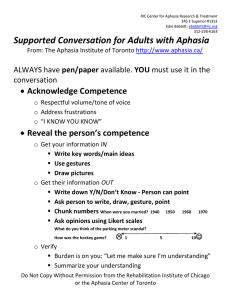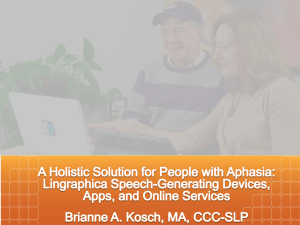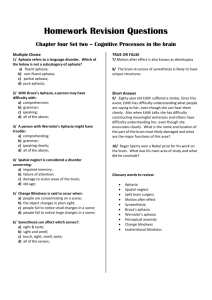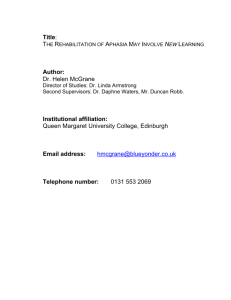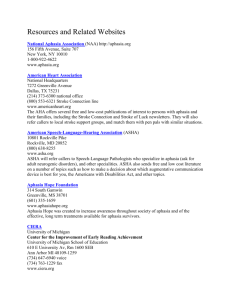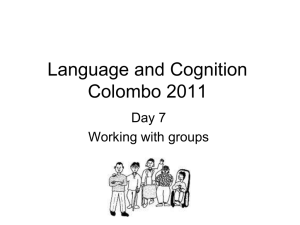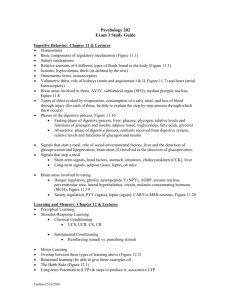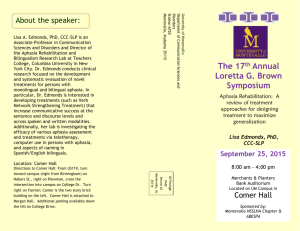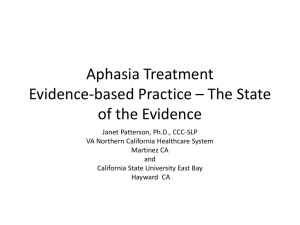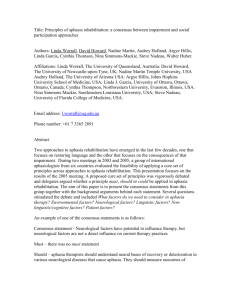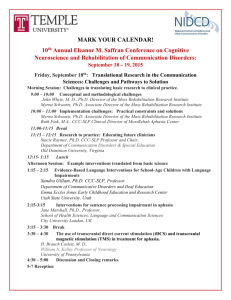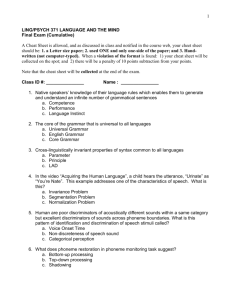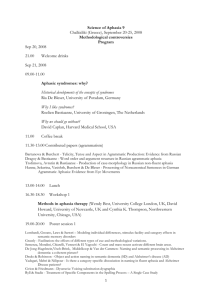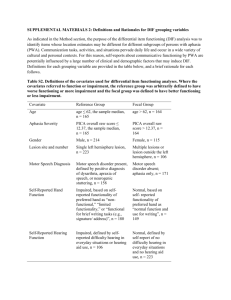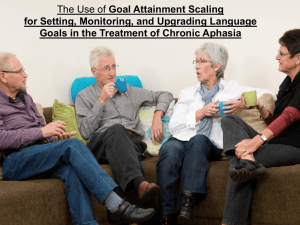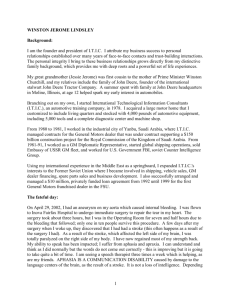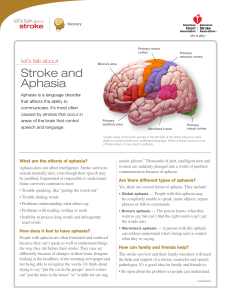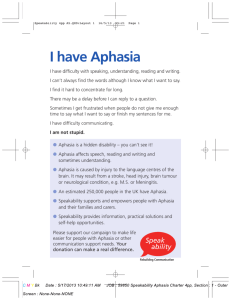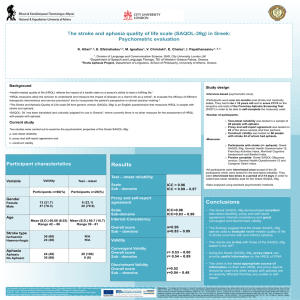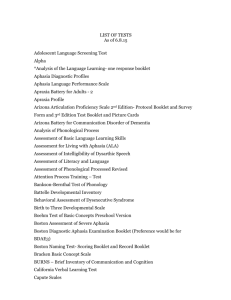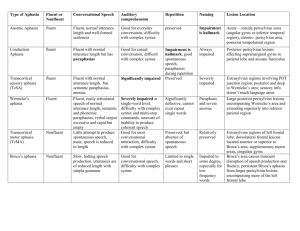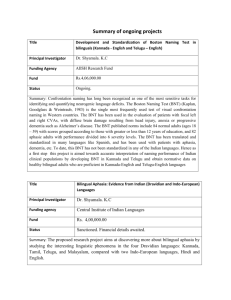14.Connors Internati..
advertisement
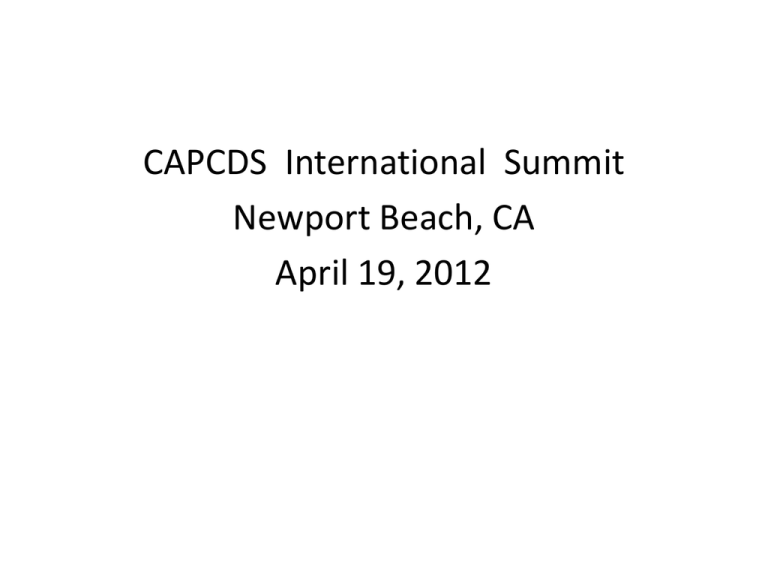
CAPCDS International Summit Newport Beach, CA April 19, 2012 International Online Services For Aphasia: Clients, Clinicians, Supervisors, and Students • William Connors, The Aphasia Center of Innovative Treatment, Inc., Pittsburgh, PA USA • Pushpa Ramachandran, The Aphasia Center of Innovative Treatment, Inc., Pune, India • Katilyn Kunkle, Bloomsburg University, PA USA • Paul Berger, Falls Church, VA USA • Janet Ross, Slave Lake, Canada will discuss online group and individual treatment and consultation with people who have aphasia, and the relevance of such work to global higher education in CSD. Content will include observations and interactions based on the presenters’ experiences delivering online services to individuals and groups in the US, Canada, India, and other countries. Implications for online clinical supervision of and participation by graduate students will also be addressed. Learning Outcomes: • List benefits of online group and individual treatment for aphasia. • List two issues in online supervision of graduate students in telepractice. 6 Big Questions for Today? • What’s it like in the tele-trenches for clients, students, clinicians, and supervisors? • What does actual telespeech look, sound, feel like? • How do we ensure that the client’s goals and values come first? 6 Big Questions for Today? • What should graduate programs do about telepractice in the student experience? • What would be the most effective and efficient ways to work with this first wave of digitally native students? • What are the best ways to exploit talents; resources; technology? Bill Connors, M.A., CCC-SLP www.aphasiatoolbox.com Pittsburgh, PA 724-494-2534; bill@aphasiatoolbox.com skype- aphasiatoolbox; oovoo- aphasia Session Plan • • • • • • • • 3:30 – 3:45 pm Introductions; groundwork 3:45 – 3:55 pm Treatment demo; Q&A Paul Berger Disadvantages-advantages 4:00 – 4:15 pm The Grad Student experience; Q&A Kaitln Kunkle 4:15 – 4:30 Treatment demos: group; text/chat; recording; practice; software 4:30-4:50 pm The international perspective; Q&A Pushpa Ramachandran 4:50 – 5:00 pm – Wrap up 5:00 pm Miller TIme Thanks • • • • CAPCDS; Brooke Hallowell To you guys All my PWA and caregivers My old mentors “Traveling the Pathways of Aphasia Recovery…” “Life without passion is unforgivable.” Sean John Statement of the Problem: • More than 1.2 million people in the United States and Canada (Brody, 1992; NAA, 2011; the Aphasia Institute, 2011) as well as millions more throughout the world, continue to suffer with hope-robbing, independence-depriving effects of aphasia despite millions of dollars spent on research, treatment, and public awareness of the problem (Kelly, 2011). The great majority of PWA and their caregivers find this state of affairs unacceptable (Worrall, 2011). Telepractice background • ASHA convention-discouraging; limiting • Encouraged; engendered determination First crude effort • Set up a corporation • Created a basic, makeshift website with some self-help for consumer and SLP protocols, materials and videos • www.skype .com • Rolled up sleeves went to work doing best I could with treatment programs and techniques and tools as we developed our own treatment philiophy, tools and treatment protocols What we quickly learned… 1. Traditional therapy is poorly suited to online treatment: What we quickly learned… 2. We need a treatment philosophy, tools and protocols that exploits both technology and neuroplasticity … What we quickly learned… 3. We needed to, “Stop acting as our clients frontal lobes.” Helm-Estabrooks What we quickly learned… 4. Group interaction and engagement is critical. 5. The focus needs to be on conversation. 6. Clients must practice 2-3 hours a day with additional work with coaches and tutors. 7. The use of formative assessment is a must. 8. Focus on reconnecting normal screen literacy, keyboarding, and spelling. What we quickly learned… 9. Say it, say it, type it, think it, say it. 10.To facilitate reconnection, thousands of neural flows are needed. 11. We usually see PWA who have exhausted much or most resources. 12.We needed to get remote access to their computers. KISS it. What we quickly learned… • What PWA want and do not want… What we have done… • Created a new website that facilitates a synergy of technology, client experience and treatment philosophy and tools. • Created a user-friendly interface and work flow for PWA; practice coach; clinician and student. • Improved the art of online videoconferencing. What we have done… • Created the Brain Compatible Aphasia Treatment Program. • Created the Motor Reconnect Apraxia Program. • Creating a network of clinicians, independent and within organizations, jumping in to telepractice. What we have done… • Collaborating with institutions and organizations. • Perform ongoing continuous quality process improvement. • Start from normal, everyday technology: computer; keyboard; emial; touchscreen; iPad; iPhone; Droid; Facebook; Voxer; Pinterest; email This tele-stuff is coming fast…. • “Even if you’re on the right track, you’ll get run over if you just sit there.” Will Rogers Paul Berger video Paul Berger consumer Kaitlyn Kunkle student Pushpa Ramachandran SLP Disadvantages Advantages Obstacles Costs Practice Apps, websites, blogs
